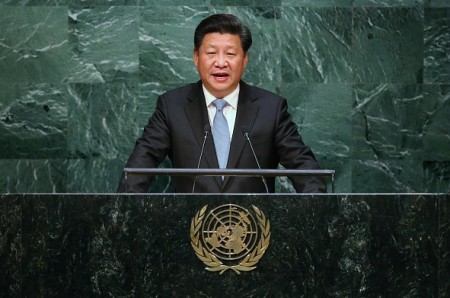By Kate Gordon

“We should firmly pursue green, low-carbon, circular and sustainable development.”
These words were spoken at the UN General Assembly today not by the head of a small and reliably eco-friendly nation (think Sweden) or by climate advocates outside the building, but by the president of the most populous nation on earth.
China appears to be embarking on a pathway to a new, more sustainable economic development model—and pushing the U.S. a little outside our own comfort zone on climate action in the process. President Xi’s UN speech was the capstone of a week of announcements that brought economic priorities squarely in line with climate priorities in a way seldom seen here in the U.S.
On Wednesday, Xi was on hand at a private business roundtable in Seattle – hosted, I’m proud to say, by the Paulson Institute – where he emphasized China’s desire to become more open to U.S. business investment, including in the kinds of clean technologies that will underpin any serious effort at energy transition. The week before, the two countries had announced a new private fund to invest in energy efficiency projects in China, also geared at facilitating clean tech deployment. Both announcements point to the critical role that business and the private sector will play in getting China’s energy transition underway.
Then, on Friday, China brought in the public sector piece of the puzzle, announcing a suite of policy commitments including a new $3B fund to help poorer countries deal with climate impacts; new power sector rules prioritizing renewable energy dispatch over more traditional fossil fueled power; and a firm promise to implement a national carbon cap and trade system for China’s most polluting industries by 2017.
The U.S. has made some strides in these areas as well, of course, especially on funds for climate adaptation in other countries through the Global Climate Fund. In that arena, China is simply catching up. But on the other commitments, especially around power sector reform and carbon pricing, the U.S. may soon be eating China’s dust. After all, though we’re currently host to two comprehensive carbon pricing systems, they cover only California and the Northeast states, not the nation. And though many states have set impressive renewable energy goals (including California’s just-passed requirement that utilities generate 50% of their power from renewable sources by 2030), the U.S. as a whole hasn’t made such a commitment.
We’ve been hearing for years from some members of Congress that the U.S. would launch into a serious effort to address climate change “if only China would act.” After this week, it looks like it’s time to make good on that promise.

For readers interested in more detail on how China can actually implement these grand plans, the Paulson Institute just published a series of papers looking in detail at carbon trading, power sector reform, demand response, and building energy disclosure policies in that country. We’re also just about to release a report making the case for sustainable economic transition in the Jing-Jin-Ji region of China, where heavy industry is still the name of the game in some provinces.


